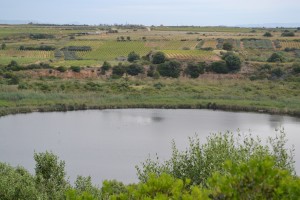 Another such family is the Sala family, whose winery, Tenuta Gorghi Tondi, is headed by sisters Annamaria and Clara. The two young women are relatively new to the wine industry, but can draw on the knowledge and experience of their father and grandfather, both of whom devoted their careers to wine. They sisters split the business duties among them and have brought in a winemaker to assist with production.
Another such family is the Sala family, whose winery, Tenuta Gorghi Tondi, is headed by sisters Annamaria and Clara. The two young women are relatively new to the wine industry, but can draw on the knowledge and experience of their father and grandfather, both of whom devoted their careers to wine. They sisters split the business duties among them and have brought in a winemaker to assist with production.
While many wineries boast stunning views, Gorghi Tondi has a particularly lovely one given its location within a natural preserve. Situated approximately 30 minutes south of Marsala in the Mazara del Vallo area, the 130 hectares of land were purchased by Annamaria and Clara Sala’s great-grandfather and were originally part of Prince Saporito’s hunting reserve. Thankfully, the land (along with its two karstic lakes, Lake Preola and Gorghi Tondi) was recognized in 1998 as a WWF Natural Reserve. Home to such vegetation as olive trees, dwarf palms and wild orchids, the reserve is equally attractive to herons, swamp hawks, mallards and other species, adding to the uniqueness of the place.
The winery itself was built in 2000 in the center of this agricultural area, with the first vintage produced in 2005. Now, nearly a decade later, Gorghi Tondi has a diverse portfolio, drawing inspiration from the Arabic culture (Rajah), general location (Meridiano 12) and proximity to the reserve (Coste a Preola as well as Sorante, which means a bird about to take flight) in naming its wines.
The range and quality of the wines was impressive, especially with the top wines, which they refer to as their Cru-level wines. However, it was their embrace of the Grillo grape variety in all its glory and many guises that really caught my attention. This cousin to Sauvignon Blanc makes its first Gorghi Tondi appearance in their Palmarès Spumante Brut; a second in the winery’s entry-level wine (not tasted); a third in the Coste a Preola Bianco, its premium label; and then again in Kheirè, among its Cru-level wines. A final appearance is the Grillo d’Oro, a botrytis-affected dessert wine. All whites (not just those produced with Grillo), with the exception of the Grillo d’Oro, are produced solely in stainless steel.
After a comprehensive tour and tasting, my hosts, Annamaria and Sal Romano (Export Manager) treated me to a snack. It was light by Italian standards, but quite a spread nonetheless. According to my agenda, I was due to have lunch at my next visit, so I tried to hold back on what I piled onto my plate, but with the tempting breads, olives, tapenades and pastas, it was difficult to resist. Plus, I welcomed the opportunity to sop up some of the alcohol I had just ingested. I was suitably rewarded as everything was as tasty as it looked, but was saved from going back for seconds, when my ride appeared, ready to whisk me away to Menfi.

For the development of a Masters thesisat the University of Palermo, is carrying out a statistical study in collaboration with the managing body of the reserve. We need your opinion. To this end, in accordance with the privacy policy, please fill out this short questionnaire, which will only take a few minutes of your time.
https://docs.google.com/forms/d/1770rQugoLCE_zqH1geFDoMg7JKF1Y-fTaNW5KvfPiUk/viewform